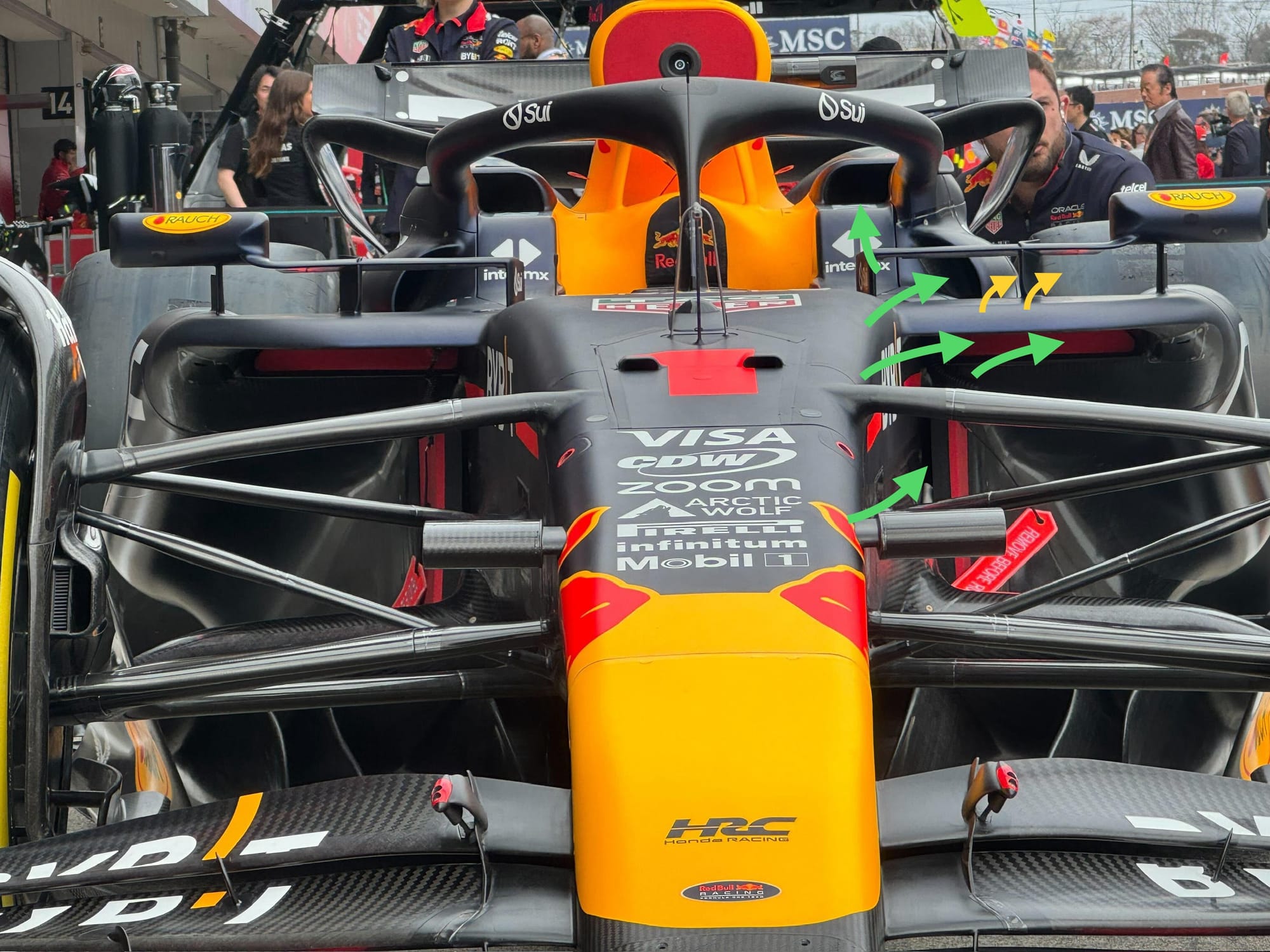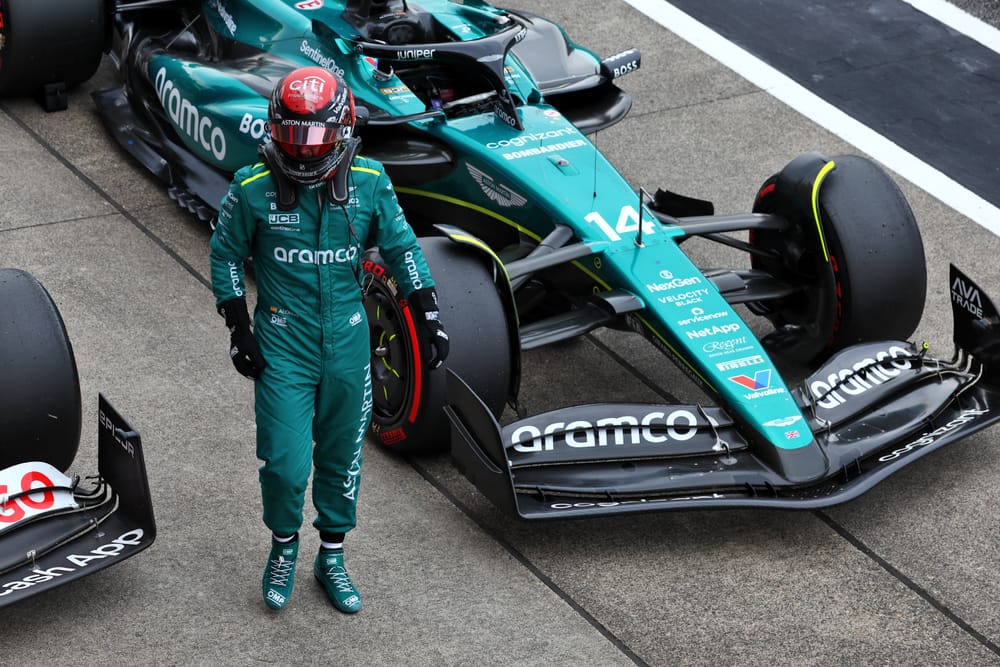Red Bull’s first major upgrade package of 2024 was introduced at Formula 1's Japanese Grand Prix, revealing that although Red Bull completely changed its car concept over the winter, the development path it’s taking is remarkably similar to 2023.
The objective last year was to minimise the performance losses caused by the car's cooling requirement, meaning we saw major steps in refining the packaging of the sidepods both in Baku in April and then in Budapest in July.
Red Bull is focusing on similar areas this year. Any airflow used to cool the car is wasted as far as generating downforce is concerned, but achieving this isn’t just about putting smaller inlet and exit holes in the body surfaces.
To optimise the inlet position, you need to search the car for surfaces that are at a positive pressure and do not have too much influence on the main airflow structure surfaces which are used to generate downforce.
To optimise the exit position, you need to do the opposite. That means you have to find a low pressure area that you either don’t want or that you could even use to help the overall airflow structure by introducing extra airflow into it for at least some of the time.
This is roughly what an ‘S-duct' did in the past. It connected the lower surface of the nose to the upper surface, which meant you could pull more airflow in under the lower nose surface. Also the ‘F-duct' (below), which was flowing air to the rear wing, and when the driver put his hand or leg over the inlet it stalled the rear wing to improve top speed. Both of these have been outlawed.
It’s not just the inlet and exit you need to optimise, it’s everything in between those two areas.
Crucially, that includes the radiator cooling cores and especially the ducting where these are positioned. To get reasonable airflow through these ducts the inlet area needs to be about 20% of the cooling core area, and the exit about 30%.
If you have roughly that as a starting point and the pressure trace across the face of the radiator cooling core is uniform, then you will have reasonable flow going through the duct and, in turn, the radiator cooling core. You can then play with the size of the exit to suit the cooling requirements for various circuits and ambient conditions.
It’s always difficult to get two pictures of different configurations at the same angle. However, from what we have, this new horizontal sidepod inlet looks wider and shallower. It’s definitely a letterbox and not a ‘parcelbox’ anymore.
The vertical chassis side inlet can be seen on the launch picture and is marked with a yellow arrow. It is still there, but obscured by the front brake duct inner fairing because of the angle of the picture.
The upper main opening is not just a vertical opening, it also has an angle so the inlet area can be deceptive. But as a rough estimate, one side of the original-specification car’s opening looked something like 30cm wide by 7cm high, which is a total area of 210cm². Using my 20% inlet area calculation, that would cater for a radiator core area of 1050cm² on each side of the car.
The new inlet looks like it is about 34cm wide and 4cm high, giving an inlet area of 136cm². That means a reduction of 74cm². That lost inlet area - or at least some of it - needs to be replaced in some other way.
Some of it could be internal duct and radiator cooling core efficiency, but I would doubt that the earlier system was so inefficient that Red Bull - or any team - could find roughly one-third of the required cooling from simply optimising the existing architecture.
All of this is to allow Red Bull to raise the lower body section of the radiator inlet. Getting this as high as possible allows it to have more mass airflow through this sidepod undercut. Managing that correctly will improve the consistency of the underfloor-scavenging devices that run along the edge of the floor.
It's not just about sealing it better when the car is close to the ground, it’s about sealing it more consistently and across a wider range of ride heights.
So all that said, at least some of that lost cooling requirement has to come from somewhere and this is where Red Bull has already found an area that it can optimise just that little bit more without paying a price on downforce. This first step shows the detail it has had to get into probably to find no more than 0.1s, if that.
The front of the headrest sides are defined in the regulations and are fairly abrupt, much like a reverse ski ramp.
On the original launch concept, the airflow that is displaced by that area would go over the top and into the duct highlighted by the purple arrows (above). However, some of it would go around the outside of the body profile and some would be displaced inwards (green arrows above, left).
This inboard flow would go between the headrest and the driver’s helmet, which could cause discomfort for the driver with helmet buffeting.
The new body profile that I have highlighted with the red line (above, right) is very similar to the earlier body profile (above, left). To me, this new duct is an add-on and not something that required a major redesign to significant body components. However, inside the body profile it is probably a very different story.
With this new duct inlet on the outside of the headrest area, most of that flow hitting the reverse ski ramp will now either go over the top into the original duct (purple arrows) or be pulled outwards into the new duct opening again (green arrows above, right).
Using a rough beer mat calculation, I think the area of that opening on one side of the car is around 40cm², so just over half of the area lost from the conventional, or as some might call it unconventional, radiator inlet.
With this new inlet being further rearward, the pressure losses generated by the duct length would be reduced, so potentially there's a small gain from that as well.
The combination of all of these inlets highlighted with the green arrows, plus the rollover bar inlet of which probably 70% of the open area is used for cooling and 30% to feed the turbo, adds up to enough cooling to satisfy the heat rejection from all of the car’s components.

The small turning vane (yellow arrows), which is an integral part of the ‘mirror mount’ (or at least that is what Red Bull tells the FIA), is there to set up a turning moment on the airflow structure to help turn that high-pressure flow outwards off the front of the abrupt headrest front surface.
So my big question is, when will we see Red Bull’s 2024 step-two radiator inlet development? We saw it in Hungary before the summer break last year. I’ll get my yellow pencil ready for that.
If you look at any other car in the pitlane, I’m afraid to say they look outdated compared to the Red Bull. I’m not saying that looks contribute to performance, but as we all know the stopwatch doesn’t lie.


